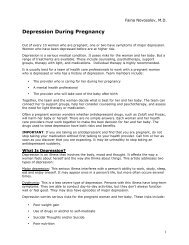The Power of Dreams: - Faina Novosolov, MD
The Power of Dreams: - Faina Novosolov, MD
The Power of Dreams: - Faina Novosolov, MD
Create successful ePaper yourself
Turn your PDF publications into a flip-book with our unique Google optimized e-Paper software.
<strong>The</strong> <strong>Power</strong> <strong>of</strong> <strong>Dreams</strong>:<br />
How to Tap the Language <strong>of</strong> Your Unconscious<br />
and Unlock Your Mind’s Potential<br />
By <strong>Faina</strong> <strong>Novosolov</strong>, M.D.
OVERVIEW<br />
• Introduction<br />
• History <strong>of</strong> Dream <strong>The</strong>rapy<br />
• Problem Solving<br />
• <strong>The</strong> Dream Interview: A Systematic Approach<br />
• 5 Steps <strong>of</strong> Dream Interviewing<br />
• Common Pitfalls <strong>of</strong> Dream Interviewing<br />
• Dream Examples<br />
• Using <strong>Dreams</strong> in Addiction Recovery<br />
• How to Introduce <strong>Dreams</strong> to Patients
INTRODUCTION
Dream Interpretation:<br />
Let Dream Central interpret your dreams!<br />
CLICK HERE TO HAVE YOUR DREAMS<br />
INTERPRETED!<br />
-Internet Websites
Top 10 Dream Symbols<br />
1. kissing<br />
2. water<br />
3. nudity<br />
4. money<br />
5. Losing a valuable object or person<br />
6. flying<br />
7. colors<br />
8. running<br />
9. sex<br />
10. teeth<br />
http://predictions.astrology.com/dd/tp10.html
What does your dream mean?<br />
www.gdelaney.com
What does your dream mean?<br />
• Throw out all your dream dictionaries.<br />
• You need to find out what “water” means to you.<br />
• <strong>Dreams</strong> tell us how we really feel/ think in our<br />
lives.<br />
• We don’t really look at all sides <strong>of</strong> the problem in<br />
waking life because we’re vested in the issue.<br />
• <strong>Dreams</strong> are your best friends.<br />
• It’s your opinion about your life.<br />
-Delaney and Flowers
HISTORY OF<br />
DREAM THERAPY
History <strong>of</strong> Dream <strong>The</strong>rapy<br />
• Ancient dream interpretative traditions date from well<br />
before the 1 st recorded dream in 2700 BC.<br />
• Physical health and illness dreams have been thought to<br />
reflect illness in the dreamer by:<br />
– Hippocrates (c460-c360 BC)<br />
– Aristotle (384-322 BC)<br />
– Galen (c130-200 AD)<br />
• Problem solving dreams<br />
• Clairvoyance or religious dreams (Joseph)<br />
• Some skeptics regarded dreams as virtually meaningless:<br />
– Cicero (106-43 BC)<br />
– Schopenhauer (1788-1860)<br />
- “Dream <strong>The</strong>rapy,” Encyclopedia <strong>of</strong> the Neurological Sciences.
History <strong>of</strong> Dream <strong>The</strong>rapy<br />
• Psychotheoretical:<br />
– Sigmund Freud (1856-1939)<br />
– Carl G. Jung (1875-1961)<br />
• Phenomenological:<br />
– Medard Boss (1903-1990)<br />
(1 st Phenomenological)<br />
– Fritz Perls (1893-1970)<br />
(Phenomenological, Gestalt type)<br />
- “Dream <strong>The</strong>rapy,” Encyclopedia <strong>of</strong> the Neurological Sciences.
History <strong>of</strong> Dream <strong>The</strong>rapy<br />
• Sigmund Freud (1856-1939):<br />
– <strong>The</strong> Interpretation <strong>of</strong> <strong>Dreams</strong> (1900)<br />
– Still considered the Western cornerstone <strong>of</strong><br />
modern dream therapy.<br />
– Uses both the analyst’s and dreamer’s<br />
associations to understand a dream.<br />
– Claimed that the purpose <strong>of</strong> dream images<br />
was to conceal the hidden repressed infantile<br />
wish that instigated the dream.<br />
– He asked the dreamer to "free-associate" to<br />
the image—a practice that usually leads to a<br />
long chain <strong>of</strong> tangential thoughts.<br />
www.gdelaney.com
History <strong>of</strong> Dream <strong>The</strong>rapy<br />
• Carl G. Jung (1875-1961):<br />
– Once a student <strong>of</strong> Freud<br />
– Jung diverged from Freud's position that<br />
the images in dreams result from an effort by<br />
the dreamer's unconscious to "censor" and<br />
disguise the hidden wish that instigated the dream.<br />
– Jung saw dreams as revealing, rather than concealing, the<br />
unconscious.<br />
– Unfortunately, in practice Jung <strong>of</strong>ten intervened with his own<br />
associations and mythological and historical associations to the<br />
image. He would <strong>of</strong>ten "explain" the meaning <strong>of</strong> an image to the<br />
dreamer, drawing upon his own reading <strong>of</strong> myths/ symbols.<br />
– Jungians believe that dreams utilize universal symbols.<br />
www.gdelaney.com
History <strong>of</strong> Dream <strong>The</strong>rapy<br />
• Medard Boss (1903-1990):<br />
– Phenomenological approach:<br />
Focus on dream elements<br />
themselves without reference to<br />
elaborate psychotheoretical<br />
formulations.<br />
– Rejected Freudian and Jungian<br />
emphasis on hypothetical<br />
constructs <strong>of</strong> the unconscious.<br />
- “Dream <strong>The</strong>rapy,” Encyclopedia <strong>of</strong> the Neurological Sciences.
History <strong>of</strong> Dream <strong>The</strong>rapy<br />
• Fritz Perls (1893-1970):<br />
– Gestault technique<br />
– Variation <strong>of</strong> the phenomenological<br />
approach<br />
– Focuses on emotions<br />
– Central feature: To encourage the<br />
dreamer to relive the dream in the<br />
present and then, with the therapist,<br />
role play characters from the dream.<br />
– Goal: To maximize the dreamer’s<br />
associated feelings.<br />
- “Dream <strong>The</strong>rapy,” Encyclopedia <strong>of</strong> the Neurological Sciences.
Historic Breakthroughs<br />
• Friedrich August Kekulé (1829-96):<br />
– Launched the field <strong>of</strong> organic chemistry<br />
– Discovered in dreams the process <strong>of</strong><br />
formation <strong>of</strong> carbon chains and the<br />
circular structure <strong>of</strong> the benzene ring.<br />
– “Let us learn to dream, gentlemen and<br />
perhaps then shall we find the truth . . .<br />
But let us also beware <strong>of</strong> publishing our<br />
dreams before they have been examined<br />
by the waking mind.” (1890)<br />
- Delaney, Breakthrough Dreaming.
Historic Breakthroughs<br />
• Dmitry Mendeleyev<br />
(1834-1907):<br />
– In a dream, he saw the<br />
periodic tables with which<br />
he had been struggling.<br />
– In the dream, “all the<br />
elements are placed as they<br />
should be. I woke up and<br />
immediately wrote it all<br />
down.”<br />
- Delaney, Breakthrough Dreaming.
PROBLEM SOLVING<br />
-Internet Photo
Problem Solving<br />
• Research support (RCT)<br />
96 Dreamers<br />
Simple<br />
Relaxation<br />
(control)<br />
Dream<br />
Incubation<br />
Distress, Anxiety,<br />
Depression<br />
- White, Gregory. “Personal Problem Solving Using Dream Incubation,” 2003.
THE DREAM INTERVIEW:<br />
A SYSTEMATIC APPROACH
5 Preparation Steps For Dreamers<br />
1. Dream Recall<br />
2. Dream Incubation (Presleep Instructions)<br />
3. Dream Recording<br />
4. Dream Diagramming<br />
5. Dream Outlining<br />
-Delaney and Flowers
Step 1: Dream Recall<br />
• Dream Journal:<br />
– Keep a notebook, in which you write the following<br />
• Day Notes:<br />
– Just before going to sleep,write date and title, “Day Note.”<br />
– Brief paragraph about major events and feelings <strong>of</strong> the day.<br />
• Recall Preparation:<br />
– Dream journal, pen and light by bedside.<br />
• Dream Recall and Recording:<br />
– Upon waking, write down any fragment, thought or feeling and<br />
title it.<br />
-Delaney and Flowers
Step 2: Dream Incubation<br />
• Dream Journal<br />
• Day Notes<br />
• Incubation Question:<br />
(Presleep Instructions)<br />
– Subtitle your Day Note, “Incubation Question.”<br />
– Be as specific as possible.<br />
• Recall Preparation<br />
• Actual Incubation:<br />
– Repeat your question to yourself as you fall asleep.<br />
– If you awake without a dream, try it again.<br />
• Dream Recall and Recording<br />
-Delaney and Flowers
Step 3: Dream Recording<br />
• Write out the dream ASAP<br />
• Rewrite the dream double spaced, typed<br />
with wide margins.<br />
• Separate scenes and number them: I, II, etc.<br />
• Include feelings for every scene.<br />
• Use italics for editorial comments from<br />
waking life.<br />
• Make a copy for your dream interviewer.<br />
-Delaney and Flowers
Step 4: Dream Diagramming<br />
Setting<br />
Person/<br />
Animal<br />
Object<br />
Feeling<br />
Action<br />
A woman<br />
had made some bread. She<br />
asked if I wanted some.<br />
-Delaney and Flowers
Step 5: Dream Outlining<br />
• Make Two Columns:<br />
– “Action” and “Feeling”<br />
– This helps clarify the action and related feelings<br />
in the dream.<br />
– It also helps to bridge the dream to waking life<br />
later on.<br />
-Delaney and Flowers
THE DREAM INTERVIEW
Dream Interviewing:<br />
3 Basic Principles<br />
1. <strong>Dreams</strong> are a metaphor for waking life.<br />
2. <strong>The</strong> action/plot <strong>of</strong> a dream is directly parallel to the<br />
waking sequence <strong>of</strong> events to which the dream refers.<br />
3. <strong>The</strong> quality <strong>of</strong> feeling in the dream coincides with the<br />
affect associated with the waking life event.<br />
-Delaney and Flowers
AXIOM: Dream interviewing is simple,<br />
but not easy.<br />
-Flowers<br />
-Internet Photo
5 STEPS OF DREAM<br />
INTERVIEWING
5 Steps Of Dream Interviewing<br />
1. Description <strong>of</strong> Major Images<br />
2. Recapitulation/ Restatement<br />
3. Bridge Metaphor to Waking Life<br />
4. Testing <strong>The</strong> Bridge, using dream details<br />
5. Summary<br />
-Delaney and Flowers
Step 1: Description<br />
• Physical Description<br />
– (setting, object, person, animal)<br />
• Function <strong>of</strong> Image (object)<br />
• Personality (person, animal)<br />
• Unique Features<br />
• Most Striking Feature<br />
• Essence<br />
• Relevant Associations<br />
• Feelings/ Judgments About Image or Action<br />
-Flowers
-Internet Photo
Step 2: Recapitulation<br />
• Edit and summarize the information obtained<br />
about the dream using the dreamer’s own words.<br />
• Encourage the dreamer to correct you: “Did I get<br />
that right?” Watch for non-verbal cues.<br />
• Polish the summary into one succinct<br />
description, using the dreamer’s own words.<br />
-Delaney and Flowers
Step 3: Bridging<br />
• Mentally divide the plot into short sequences.<br />
• Ask dreamer to repeat the 1 st sequence with feelings<br />
included: “So tell me again, where were you at the<br />
beginning <strong>of</strong> the dream and what happened?”<br />
• <strong>The</strong> Bridge Question:<br />
– “Is there anywhere in your life that you are in a place which<br />
is like…. (repeat dreamer’s description) and where (what is<br />
happening in the dream) is (metaphorically) happening in<br />
your waking life?”<br />
– “Does X, whom you describe as (recapitulate the<br />
description) remind you <strong>of</strong> anyone, anything, or any part <strong>of</strong><br />
yourself?”<br />
-Delaney
Step 3: Bridging (cont.)<br />
• Allow time for the dreamer to think.<br />
• DO NOT pressure, hint or suggest.<br />
• If necessary, use these strategies to help the dreamer think<br />
<strong>of</strong> a parallel life situation:<br />
– Repeat or rephrase question<br />
– Remind dreamer this is a metaphor for something in waking life<br />
– Ask what possibly fits the description and feeling<br />
– Encourage speculation<br />
– Check you are using dreamer’s own words<br />
• Personalities: Often bridge to parts <strong>of</strong> the dreamer or<br />
someone else<br />
• Move to the next sequence even if you don’t bridge the 1 st<br />
-Delaney
AXIOM: Think <strong>of</strong> the<br />
interviewer as the<br />
footman with the glass<br />
slipper, looking for<br />
Cinderella – the best<br />
fitting interpretation: She<br />
may not be found today,<br />
but she’s out there<br />
somewhere!<br />
-Flowers<br />
-Internet Photo
Step 4: Testing the Bridge<br />
• Clarify how the dreamer sees the parallel<br />
between the dream and waking life:<br />
– “How does that fit?”<br />
• Check that the major details <strong>of</strong> action fit the<br />
bridge.<br />
• Check that the major feelings fit the bridge.<br />
• When a bridge fits, all sequences should interpret<br />
consistently.<br />
• If a bridge fails a test, ask the dreamer for an<br />
alternative.<br />
-Delaney
Step 5: Summary<br />
• Ask the dreamer to summarize his/her<br />
understanding <strong>of</strong> each scene, reiterating major<br />
bridges.<br />
• At the end, have the dreamer recount the whole<br />
dream one last time, prior to giving the final<br />
interpretive summary.<br />
• Ask the dreamer if he/she has learned anything<br />
about themselves.<br />
• Consider options for actions: Ask the dreamer<br />
what he/she might do with the new information.<br />
-Delaney and Flowers
COMMON PITFALLS<br />
OF DREAM INTERVIEWING<br />
-Internet Photo
Common Pitfalls:<br />
1. Being the expert<br />
2. Upstaging<br />
3. Pride and Prejudice<br />
4. Translating<br />
5. Losing the Scent<br />
6. Jumping to Conclusions<br />
7. Not Prioritizing<br />
8. Chasing Tangents<br />
9. Lagging<br />
10. Drowning in Detail<br />
11. Isolating an Image<br />
12. Poorly Timed Interruptions<br />
13. Losing Momentum<br />
14. Feeling Too Responsible<br />
15. Overworking Dream(er)<br />
16. Leading the Witness<br />
17. Being Seduced<br />
18. Failure to Test Bridge<br />
19. Takeover<br />
20. <strong>The</strong> Winner’s Complex<br />
-Delaney and Flowers
DREAM EXAMPLES
Example 1:<br />
“My Hidden Constrictor”<br />
-Internet Photo
Example 1: “My Hidden Constrictor”<br />
Gina: “I have a boa constrictor wrapped around my<br />
body underneath my clothes. No one but me knows<br />
it’s there, not even my therapist. <strong>The</strong> boa’s head,<br />
which is like a double fish head, is at my heart,<br />
poised to strike me with its venom if I do the wrong<br />
thing. It squeezes me if I even think the wrong<br />
thing. I am very anxious, for at any moment, if I do<br />
something inappropriate or sudden, it could kill me<br />
or squeeze the breath out <strong>of</strong> me. I just live with it<br />
like this. No one knows the danger I am in. I realize<br />
I must kill the snake. It makes me sad to think I<br />
must kill it.”<br />
-excerpt from Breakthrough Dreaming, Delaney.
“My Hidden Constrictor” cont.<br />
• Describe a boa constrictor:<br />
– “Boas eat things whole; they are overpowering;<br />
they squeeze their victims to s<strong>of</strong>ten them up – and<br />
perhaps kill them – before swallowing them. This<br />
one is poised over my heart, and so can strike with<br />
its venom at the most vital center <strong>of</strong> my being – the<br />
center <strong>of</strong> my feelings.”<br />
• How does it feel to have this thing wrapped<br />
around you wherever you go?<br />
– “Terrifying. I have to monitor everything I do and<br />
say or the snake will kill me.”<br />
• At this point, Gina was still unable to bridge.<br />
-excerpt from Breakthrough Dreaming, Delaney.
“My Hidden Constrictor” cont.<br />
• What about the odd double fish head <strong>of</strong> the snake?<br />
– Gina spontaneously bridged to her alcoholic father, who had 2<br />
sides to his personality.<br />
– Her need to be loved by her father led her to live constricted<br />
and even threatened by his venomous disapproval.<br />
– This explained why she had developed such a friction-free way<br />
<strong>of</strong> dealing with people.<br />
– She didn’t dare be spontaneous.<br />
– She was living an emotionally constricted life, captive to this<br />
snake (need for approval).<br />
– She had a secret fear <strong>of</strong> retaliation against independent<br />
thinking.<br />
– This was especially clear in her relationships with men.<br />
-excerpt from Breakthrough Dreaming, Delaney.
Example 2: “Butter Melter”<br />
-Internet Photo
Example 2: “Butter Melter”<br />
• Cynthia incubated the following question:<br />
– “How do I help my boyfriend with his weight<br />
management?”<br />
• Cynthia’s dream:<br />
– “I am with my boyfriend in his luxurious car. Things<br />
are fine, and then I discover that there is a butter melter<br />
built into the car on the dashboard. I say, ‘Gee, this is<br />
great, but what are we gonna do with it?’ I fiddle with<br />
it and try to turn it into a tea server. This isn’t easy; I’m<br />
having trouble when I awake.”<br />
-excerpt from Breakthrough Dreaming, Delaney.
“Butter Melter” cont.<br />
• What is a butter melter and how does it work?<br />
– “I’ve never seen one before in waking life, but the one<br />
in the dream had a button you could push and the<br />
stick <strong>of</strong> butter would pop down into the receptacle<br />
that would melt the butter. <strong>The</strong>n, you could turn a<br />
spigot and melted butter would pour out!”<br />
• What do you think about such a device?<br />
– “It is very luxurious and surprising.”<br />
• Who put it there and why?<br />
– “It was put in at the factory. It was built in, and the<br />
car just came that way.”<br />
-excerpt from Breakthrough Dreaming, Delaney.
“Butter Melter” cont.<br />
• What is butter?<br />
– “It is a fat, and it makes you fat. It is unhealthy, the quintessential<br />
fat. Me and my boyfriend, Hercule, are very careful about not<br />
having too much fat in our diets.<br />
• Is there anything about your boyfriend that is like butter, a<br />
fat you are careful not to have too much <strong>of</strong>, but that is built<br />
in at the factory?<br />
– “Well, he yo-yos with his weight, and his tendency to eat foods<br />
like butter and his weight problem is probably built in, at least<br />
from childhood. He certainly came that way! You know, I<br />
incubated this dream, but I thought it had nothing to do with my<br />
question, which was: How can I help Hercule with his weight<br />
management? I think the dream is telling me to back <strong>of</strong>f a bit, and<br />
allow for the built-in quality <strong>of</strong> this problem. It wasn’t working<br />
too well to turn his butter dispenser into a tea dispenser.”<br />
-excerpt from Breakthrough Dreaming, Delaney.
USING DREAMS IN<br />
ADDICTION RECOVERY
<strong>Dreams</strong> in Addiction Recovery<br />
• A good understanding <strong>of</strong> dynamics can be helpful in<br />
formulating behavioral strategies and deepening the<br />
quality <strong>of</strong> recovery.<br />
• Increased dream recall is a commonly experienced<br />
symptom in addiction recovery.<br />
• Thus, dreams provide a rich source <strong>of</strong> treatment.<br />
• Client has ultimate authority over interpretation.<br />
• Collaboration with therapist.<br />
• Good tool to manage feelings.<br />
• Utilizing nightmares models the conversion <strong>of</strong> distress<br />
into a resource.<br />
- Flowers, “<strong>The</strong> Dream Interview Method in Addiction Recovery,” 1996.
Dream Example:<br />
“White Water Rafting”<br />
-Internet Photo
Example: “White Water Rafting”<br />
• Roger dreamt:<br />
“I was white water rafting with a group <strong>of</strong><br />
friends. <strong>The</strong> water was relatively calm and then<br />
it started to pick up. Things started to get out <strong>of</strong><br />
control, it got very rocky. <strong>The</strong> waters were<br />
going very fast and I fell out <strong>of</strong> the raft into the<br />
water. I was losing consciousness. <strong>The</strong> water<br />
was very cold, I may have hit my head, and I<br />
wasn't sure that I would come back up again.”<br />
- from Website: http://www.gdelaney.com, Delaney.
“White Water Rafting” cont.<br />
• Describe the action in your dream.<br />
– “<strong>The</strong> most striking part <strong>of</strong> it was that everything<br />
seemed so calm and in control at first. <strong>The</strong>n the<br />
natural course <strong>of</strong> the river simply started to speed<br />
things up. I lost control and was afraid I would go<br />
under and die.“<br />
• Do these feelings remind you <strong>of</strong> any situation in<br />
your life?<br />
– “Yes, this is how I feel when I get near drugs again<br />
and, in fact, the people in the boat were friends I<br />
used to do drugs with.”<br />
- from Website: http://www.gdelaney.com, Delaney.
“White Water Rafting” cont.<br />
• Currently he was <strong>of</strong>f drugs and felt very in<br />
control. But, in the last week he had started<br />
seeing some <strong>of</strong> these former drug friends<br />
again even though he wasn't using.<br />
• Roger understood his dream to be pointing<br />
out to him how easy it would be to lose<br />
control, to fall back into his old habits and<br />
perhaps lose his life to his habit.<br />
- from Website: http://www.gdelaney.com, Delaney.
HOW TO INTRODUCE<br />
DREAMS TO PATIENTS
How to Introduce <strong>Dreams</strong> to Patients<br />
• “I am interested in discussing dreams with you.<br />
Do you have any interest in including dream<br />
work in our therapy?”<br />
• WHY?:<br />
– I’ve found it to be impressively helpful<br />
– Expedites therapy<br />
– A tool you can use outside <strong>of</strong>/ after therapy<br />
– Gives a “heads up”/ anticipation <strong>of</strong> issues before<br />
they emerge as problems<br />
– Nightmares usually occur when we still have time to<br />
fix it: Red Flags.<br />
-Flowers
Thank You and Pleasant <strong>Dreams</strong>!<br />
A special thank you to Drs. Loma Flowers and Gayle<br />
Delaney for introducing me to the amazing world <strong>of</strong><br />
dreams, and for all their help and support.<br />
-Internet Photo
Bibliography<br />
1. Crook, Rachel E. and Clara E. Hill. “Working with <strong>Dreams</strong> in<br />
Psychotherapy: <strong>The</strong> <strong>The</strong>rapist’s Perspective.” Dreaming, Vol. 13<br />
(2), June 2003, pp 83-93.<br />
2. Delaney, Gayle. Breakthrough Dreaming: How to tap the power <strong>of</strong><br />
your 24-hour mind. New York: State University <strong>of</strong> New York<br />
Press, 1993.<br />
3. Delaney, Gayle. New Directions in Dream Interpretation. New<br />
York: Bantam Books, 1991.<br />
4. Flowers, Loma K. “<strong>The</strong> Morning After: A pragmatist’s approach to<br />
dreams.” Psychiatric Journal <strong>of</strong> University <strong>of</strong> Ottowa, Vol. 13 (2),<br />
1998, pp66-71.<br />
5. Flowers, Loma K. “<strong>The</strong> Use <strong>of</strong> Presleep Instructions and <strong>Dreams</strong> in<br />
Psychosomatic Disorders.” Journal <strong>of</strong> Substance Abuse Treatment,<br />
Vol. 13 (2), 1996, pp 99-105.<br />
6. Flowers, Loma K. and Gayle Delaney. Handouts entitled: “Dream<br />
Interviewing: A contemporary method <strong>of</strong> dream interpretation.”
Bibliography cont.<br />
7. Flowers, Loma K. and Gayle Delaney. “Dream <strong>The</strong>rapy.”<br />
Encyclopedia <strong>of</strong> the Neurological Sciences, 2003.<br />
8. Flowers, Loma K. and Joan E. Zweben. “<strong>The</strong> Changing Role <strong>of</strong><br />
‘Using’ <strong>Dreams</strong> in Addiction Recovery.” Journal <strong>of</strong> Substance<br />
Abuse Treatment, Vol. 15 (3), 1998, pp 193-200.<br />
9. Flowers, Loma K. and Joan E. Zweben. “<strong>The</strong> Dream Interview<br />
Method in Addiction Recovery.” Journal <strong>of</strong> Substance Abuse<br />
Treatment, Vol. 13 (2), 1996, pp 99-105.<br />
10. Website: http://www.gdelaney.com<br />
11. White, Gregory L. and Laurel Taytroe. “Personal Problem-<br />
Solving Using Dream Incubation: Dreaming, relaxation, or<br />
waking cognition?” Dreaming, Vol. 13 (4), December 2003, pp<br />
193-209.<br />
12. Wonnell, Teresa L. and Clara E. Hill. “Predictors <strong>of</strong> Intention to<br />
Act and Implementation <strong>of</strong> Action in Dream Sessions: <strong>The</strong>rapist<br />
skills, level <strong>of</strong> difficulty <strong>of</strong> action plan, and client involvement.”<br />
Dreaming, Vol. 15 (2), 2005, pp 129-141.





